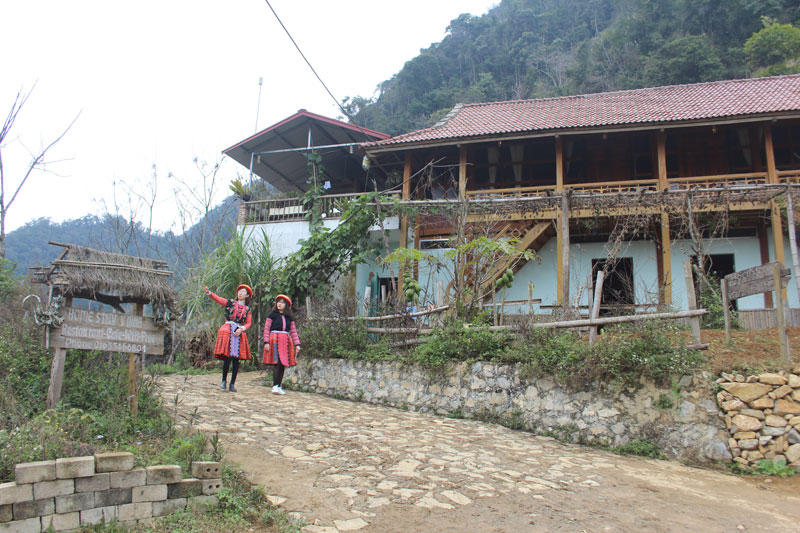
(HBO) – The Mong ethnic people in Hang Kia commune, Mai Chau district were long used to farming and hunting. Till one day, several households in Hang Kia village thought of opening lodging facilities to attract tourists, since then a number of standard home-stay services have sprung up.
Sung Y Mua home-stay facility lies in a
"gateway” location in Hang Kia commune. It sits along a main road and features
a space similar to the architecture of the Mong people, from land shape,
decorations to eye-catching and harmonious
layout of the living room. According to Sung Y Mua, owner of the home-stay
facility, she always puts herself in visitors’ shoes to learn about their needs
and tastes, thus making them feel the most comfortable.

Sung Y Mua in Mong earthen-walled
house attracts many tourists

Well-furnished accommodation
space

Home-stay facility always
offers good services
Located nearby, Son Bac home-stay
facility on hill A1, Hang Kia 3 hamlet is also one of the two familiar tourist destinations
in Hang Kia valley. Its owner Giang Y Dua invested in infrastructure to make it
easier for visitors to go up and down the top of the hill from which they could
see a panorama of the valley and a zigzag path in Pa Khom hamlet leading to
neighbouring Laos.
They are two out of the four
home-stay facilities developed in Hang Kia valley since 2016. Each could
accommodate a maximum of 50 guests on average per day. Visitor Ho Khac Tien from
Hoa Binh city said living conditions here are quite good so that more tourists
will come.
Via training, the catering
staff here has become more professional and considerate. Many kinds of foods
are cooked in Mong ethnic style.

From the top of hill A1,
tourists could see a panorama of the beautiful Hang Kia valley.
Domestic and foreign visitors
are impressed by the Mong people’s home-stay facilities where they could
experience the best services such as exploring nature with tour guides, taking
a hunting tour, growing rice and corn, picking up plums and peaches, weaving
linen, drawing paintings using bee wax, playing folk games, and joining music
exchanges.
They are also able to hire
bicycles to travel around Hang Kia, borrow Mong costumes and go hiking,
climbing mountain, stroll around blooming plum and peach forests. Foot soaking
with herbs, free wifi and karaoke services are also available./.
A diverse chain of eco-tourism and resort destinations concentrated in Hoa Binh city and the districts of Tan Lac, Da Bac, and Luong Son… Along with the launch of several key high-quality resort tourism projects, these developments have reshaped the landscape and enhanced the appeal of Hoa Binh as a travel destination.
Boasting diverse terrain, a mild climate, and rich natural resources, Cao Phong district is increasingly asserting its place on Vietnam’s tourism map, attracting both domestic and foreign visitors. The district is renowned for its stunning landscapes, majestic mountains, a crystal-clear hydropower lake, and the unique cultural identity of local ethnic groups.
With its pristine landscapes, unique cultural heritage of Muong ethnic minority, and an expanding range of visitor experiences, Tan Lac district of Hoa Binh has fast become a captivating destination for both domestic and international tourists.
Until now, Sung village in Cao Son commune, Da Bac district remains the only Dao ethnic community in Hoa Binh province to develop a community-based tourism model. Beyond its untouched natural landscapes, cultural identity serves as the cornerstone attraction for visitors.
Alongside the diverse cultural identities of the Kinh, Muong, Tay, Thai, Dao, and Mong ethnic people, Hoa Binh province is also renowned as the "capital" of the northwestern Vietnamese cuisine, offering unique and distinctive dishes. At festivals, during Lunar New Year (Tet), or on significant family or community occasions, special dishes are prepared, leaving a lasting impression on visitors.
A Phong Linh (Yellow Tabebuia) flower garden in Thang village, Thach Yen commune, Cao Phong district is currently in full bloom, drawing a large number of visitors.






